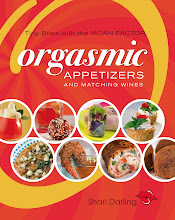
Part Two of Romancing the Grape -- The Wine List
The restaurant wine list can be intimidating. Restaurateurs will tell you that some of their finest vintages never sell because the names of wines can be difficult to pronounce. Gewurztraminer, for example, is one of those wines. Pronounced ‘ge-wurz-tra-meener’, this white is full bodied, is produced both dry and off-dry and offers wonderful aromas and flavours of flowers, spice, and tropical fruit, depending on the terroir in which the grapes are grown.
While it may be ideal to partner to spicy Thai dishesa and East Indian cuisine, Gewurztraminer is often avoided. Many customers would rather refrain from mispronouncing the name and therefore looking bad to their fellow companions than in trying something new.
Don't be shy to ask the wait-person or sommelier how to pronounce the wine. Their job is to both educate you and create your culinary experience.
Add to this that every restaurant has its own individualistic approach to creating the wine list. Lists can be organized and simple, dividing by country, grape variety, style, price and/or region. Other lists look like a novel, listing pages upon pages of vintages.
So how does the average, novice wine lover read the wine list? The answer is by process of elimination and the art of experimentation.
First, are you a foodie who sips wine or a wino who likes to eat? Foodies choose the dish and then find a wine to match. Winos choose the wine and then order a dish accordingly.
What is your budget? I like to hunt for unique and quality wines at reasonable prices. Given that most wines are marked up by 100%, I refrain from drinking these excessively expensive vintage while dining out.
Next, eliminate the house wine. They are often inexpensive, non descript red and white wines, purchased by price rather than quality. They carry the highest mark-up, as well.
No doubt the easiet way to choose is to match a regional wine to a regional food and to stay within your budget.
And then there are those foodies and winos who operate by their emotions above budget and palate. They choose wine according to their mood.
So, there are no hard and fast rules that can be applied to choosing wine from the list for each kind of wine lover.
Most people choose wine to partner to the entree.
If you feel like drinking white wine, then choose a style that will match your dish. All wines fall into various styles. Within each style you'll find an array of grape varieties or 'varietal' wines. The style will dictate the wine's most predominant taste sensations, such as tangy and fruit or fruity and sweet. The taste sensations are key when pairing wine to food.
The terrior in which the grape is grown will determine the wine's flavours on the nose and palate. While two whites may be light and crisp, one can have citrus flavours in the aromas while another might be more floral. Flavours are less important in creating harmony on the palate between the wine and food.
Pair your entree to a wine's taste sensations.
Crisp dry whites (Sauvignon Blanc) work with tangy dishes highlighting ingredients like goat cheese or feta or salty dishes, such as caviar or smoked salmon.
Off dry white wines offset heat and spice and complement foods slightly sweet, such as those featuring sweet potato.
Full-bodied, oaky whites (Chardonnay) harmonize with fatty foods like cream-based or butter-based sauces over pasta.
If you enjoy red wine, then there are three basic styles from which to choose -- light fruity reds like Pinot Noir), reds with forward fruit (like Shiraz) or austere reds(Cabernet Sauvignon).
Light, fruity reds marry well with oily fish like salmon and tuna, as well as chicken or fresh tomato based sauces over pasta.
If you prefer gentle heat and spice choose a red wine with forward fruit as the tannin tends to be soft, thereby not interfering with the heat and spice. This style also complements roasted tomato sauces and can complement chicken, beef or duck.
Heavier reds work best with red meats, salty cured meats like prosciutto and salty, hard cheese like Romano or Parmesan.
Consider experimenting. Ask the server to recommend a wine. Take a chance. Before ordering, request samples of a few wines. This will give you the opportunity to experiment and try the wines before spending your hard earned dollars.
Buy wine by the bottle. If dining with two or more guests, it’s cheaper to order by the bottle than by the glass.
If you’re interested in expanding your knowledge, ask the server if you can try a half glass of two wines (listed at the same price) rather than ordering a full glass of wine.
If you like a certain grape variety, such as chardonnay or cabernet sauvignon, try ones from different wine regions and/or countries. An Ontario chardonnay, considered a wine produced in a cool climatic region, for example, has a completely different taste profile than a chardonnay produced in a warm climate, such as South Africa. Ontario chardonnays are lighter in style with a good backbone of acidity. The acidity cleans the palate between bites, thus making them good food wine.
A South African chardonnay will be heavier in style, more suited for heavier dishes, such as cream based pasta. The more sunshine hours over a growing season and the hotter the temperatures of a region, the greater the sugar level in the grapes. During fermentation sugar is converted to alcohol and carbon dioxide. The carbon dioxide dissapates, leaving alchol in the wine. So warm climates tend to produce wine with higher alcohol. Alcohol creates viscosity or thickness on the palate. It is experienced as mouth feel. Wines with high alcohol can have a heavy or creamy texture, thus making them suitable for fattier dishes.
Don’t shy away from trying new wines because the grape variety is hard to pronounce. Ask the server to pronounce the name for you and have him/her explain the qualities of the wine.
If ordering two glasses of wine, rather than a bottle, try different ones. Save a little wine from your first glass to compare against the new wine in your second glass. This simple act, alone, will aid in expanding your love and understanding of the fermented grape.
There's only one guideline I like to stress and that is to keep an open mind and try a different wine every time you dine out, exploring wine regions from around the world. This is the only way to finally discover the wines that fit into your personal taste profile.





No comments:
Post a Comment